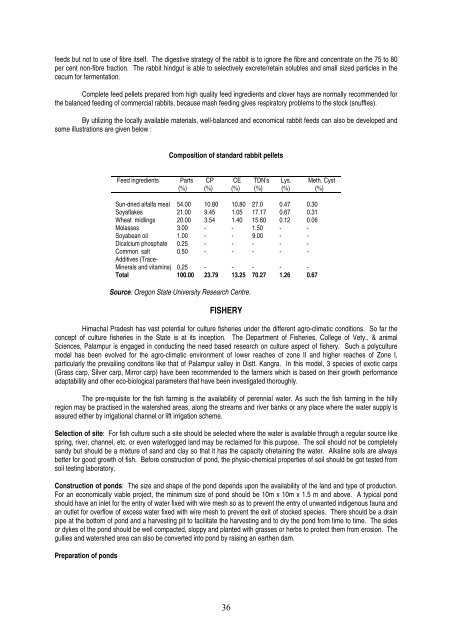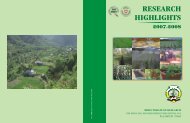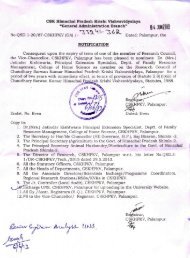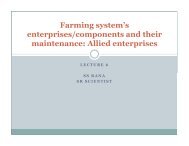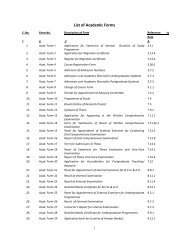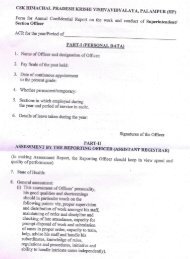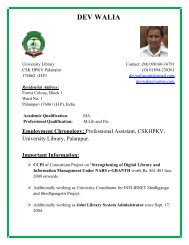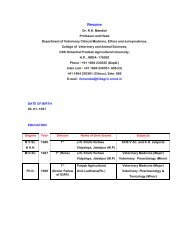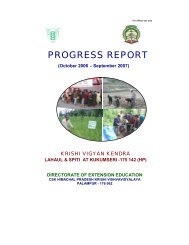animal production - CSK Himachal Pradesh Agricultural University ...
animal production - CSK Himachal Pradesh Agricultural University ...
animal production - CSK Himachal Pradesh Agricultural University ...
You also want an ePaper? Increase the reach of your titles
YUMPU automatically turns print PDFs into web optimized ePapers that Google loves.
feeds but not to use of fibre itself. The digestive strategy of the rabbit is to ignore the fibre and concentrate on the 75 to 80<br />
per cent non-fibre fraction. The rabbit hindgut is able to selectively excrete/retain solubles and small sized particles in the<br />
cecum for fermentation.<br />
Complete feed pellets prepared from high quality feed ingredients and clover hays are normally recommended for<br />
the balanced feeding of commercial rabbits, because mash feeding gives respiratory problems to the stock (snuffles).<br />
By utilizing the locally available materials, well-balanced and economical rabbit feeds can also be developed and<br />
some illustrations are given below :<br />
Composition of standard rabbit pellets<br />
Feed ingredients Parts CP CE TDN’s Lys. Meth. Cyst<br />
(%) (%) (%) (%) (%) (%)<br />
Sun-dried alfalfa meal 54.00 10.80 10.80 27.0 0.47 0.30<br />
Soyaflakes 21.00 9.45 1.05 17.17 0.67 0.31<br />
Wheat midlings 20.00 3.54 1.40 15.60 0.12 0.06<br />
Molasses 3.00 - - 1.50 - -<br />
Soyabean oil 1.00 - - 9.00 - -<br />
Dicalcium phosphate 0.25 - - - - -<br />
Common salt 0.50 - - - - -<br />
Additives (Trace-<br />
Minerals and vitamins) 0.25 - - - - -<br />
Total 100.00 23.79 13.25 70.27 1.26 0.67<br />
Source: Oregon State <strong>University</strong> Research Centre.<br />
FISHERY<br />
<strong>Himachal</strong> <strong>Pradesh</strong> has vast potential for culture fisheries under the different agro-climatic conditions. So far the<br />
concept of culture fisheries in the State is at its inception. The Department of Fisheries, College of Vety., & <strong>animal</strong><br />
Sciences, Palampur is engaged in conducting the need based research on culture aspect of fishery. Such a polyculture<br />
model has been evolved for the agro-climatic environment of lower reaches of zone II and higher reaches of Zone I,<br />
particularly the prevailing conditons like that of Palampur valley in Distt. Kangra. In this model, 3 species of exotic carps<br />
(Grass carp, Silver carp, Mirror carp) have been recommended to the farmers which is based on their growth performance<br />
adaptability and other eco-biological parameters that have been investigated thoroughly.<br />
The pre-requisite for the fish farming is the availability of perennial water. As such the fish farming in the hilly<br />
region may be practised in the watershed areas, along the streams and river banks or any place where the water supply is<br />
assured either by irrigational channel or lift irrigation scheme.<br />
Selection of site: For fish culture such a site should be selected where the water is available through a regular source like<br />
spring, river, channel, etc. or even waterlogged land may be reclaimed for this purpose. The soil should not be completely<br />
sandy but should be a mixture of sand and clay so that it has the capacity ofretaining the water. Alkaline soils are always<br />
better for good growth of fish. Before construction of pond, the physic-chemical properties of soil should be got tested from<br />
soil testing laboratory.<br />
Construction of ponds: The size and shape of the pond depends upon the availability of the land and type of <strong>production</strong>.<br />
For an economically viable project, the minimum size of pond should be 10m x 10m x 1.5 m and above. A typical pond<br />
should have an inlet for the entry of water fixed with wire mesh so as to prevent the entry of unwanted indigenous fauna and<br />
an outlet for overflow of excess water fixed with wire mesh to prevent the exit of stocked species. There should be a drain<br />
pipe at the bottom of pond and a harvesting pit to facilitate the harvesting and to dry the pond from time to time. The sides<br />
or dykes of the pond should be well compacted, sloppy and planted with grasses or herbs to protect them from erosion. The<br />
gullies and watershed area can also be converted into pond by raising an earthen dam.<br />
Preparation of ponds<br />
36


